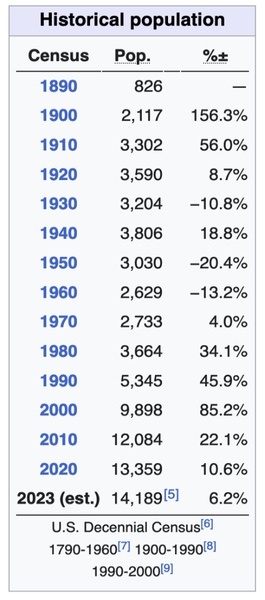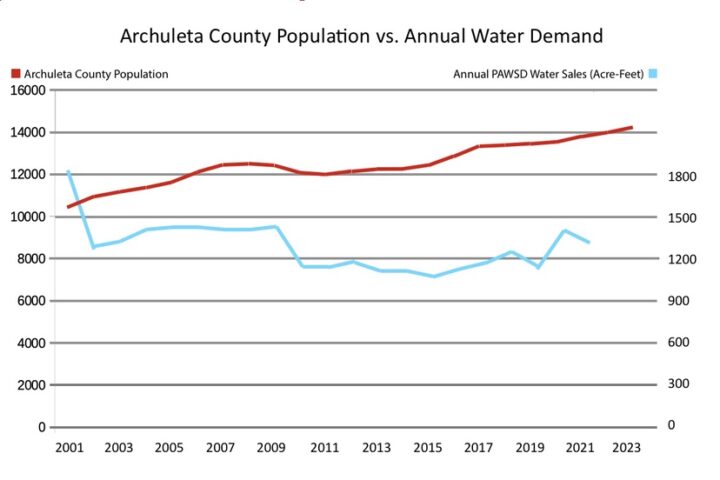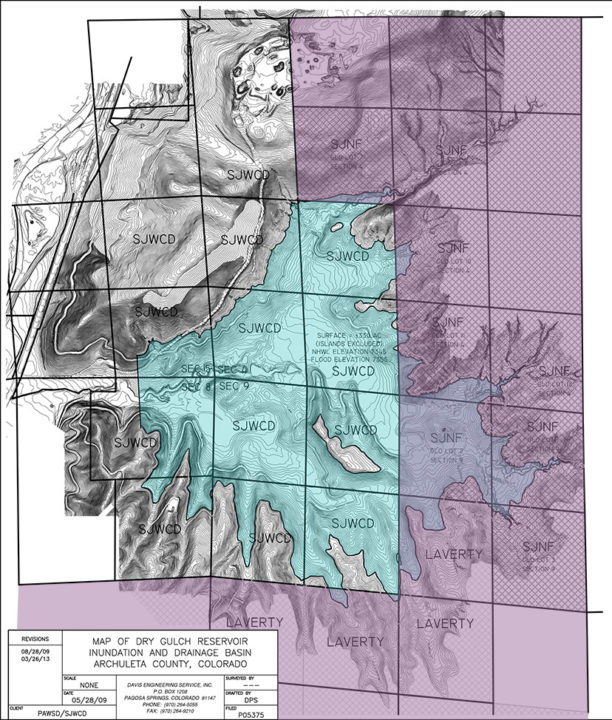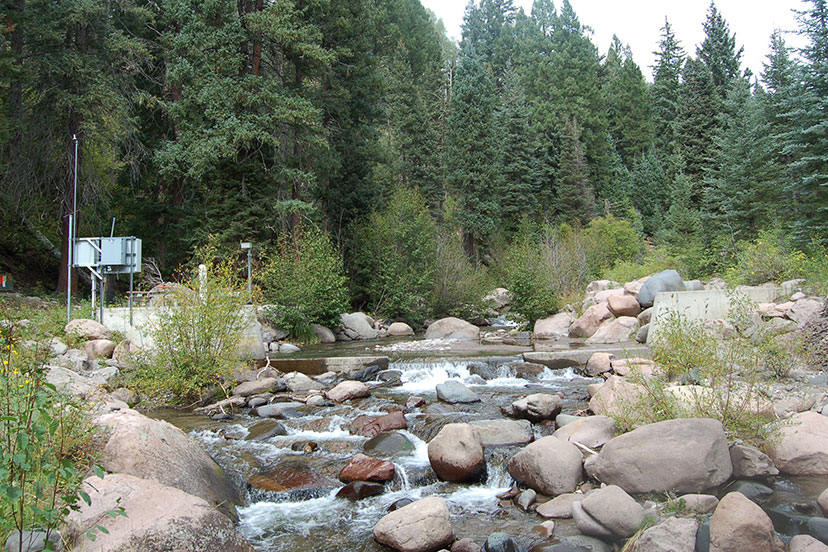Photo: The site of the Fourmile Creek diversion that provides drinking water for Pagosa Area Water and Sanitation District.
The San Juan Water Conservancy District held a special meeting yesterday, to discuss — among other things — the idea of hiring a project manager for a proposed 11,00 acre-foot reservoir on the former Running Iron Ranch north of downtown Pagosa Springs. They also approved four letters addressed to prominent Colorado politicians and bureaucrats, asking for their support for the project.
I attended the meeting, and brought along a graph to share, showing some historical population and water demand data. We’ll look at that graph in a moment.
Curiously, the SJWCD Board is seeking assistance from political organizations outside the Pagosa community, but — to judge by yesterday’s decisions — doesn’t appear to be terribly interested in cooperating with the local government board that’s been paying the mortgage on the former Running Iron Ranch. That is, the Pagosa Area Water and Sanitation District (PAWSD) Board.
Disclosure: I currently serve as a volunteer on the PAWSD Board of Directors, but this editorial reflects only my own personal opinions and not necessarily the opinions of the PAWSD Board as a whole.
As mentioned previously in this editorial series, the San Juan Water Conservancy District came into existence in 1989 with the mission of creating additional water reservoirs in Archuleta County. Back then, Pagosa Springs was starting to show signs of population growth after a long period of stagnation.
Here’s a chart from Wikipedia:

As we can see, the population of the county was smaller in 1970 than it was in 1910. But in 1970, developers were arriving… buying up cattle ranches and turning them into subdivisions… and practically overnight (or so it seems, looking back) two key industries blossomed in Pagosa Springs: home construction and real estate.
By 1990, the population had doubled. And by 2000, it had nearly doubled again.
Obviously, the community was going to run out of water, unless something was done, and done rather quickly. Or so we were told.
Enter, stage right, Fred W. Schmidt, president of the San Juan Water Conservancy District (SJWCD), and Jack DeLange, manager of Pagosa Area Water and Sanitation District (PAWSD) with a plan for a 32,000-acre-foot reservoir in the Dry Gulch valley. At the time, PAWSD was selling about 1,200 acre-feet of water per year, so this proposed reservoir would theoretically hold 26 years worth of municipal water… if the community’s water demand stayed the same.
But no one expected the water demand to stay the same. In fact, PAWSD and SJWCD expected water demand to grow as fast as the Archuleta County population. Which seemed like common sense.
But common sense was wrong.
In the graph below, the red curve indicates Archuleta County population growth since 2001… and the blue curve indicates the changes in PAWSD water sales… which have been a roller coaster. (Population based on US Census data; water sales based on PAWSD data.)

The blue line shows water demand in 2021 at almost the exact same level as in 2002, two decades earlier.
And significantly below the demand in 2001. In 2002, water demand fell precipitously as a result of a serious local drought. Water demand dipped again in 2010, probably as a result of the Great Recession. Since then, water demand has generally remain below the 2002 level, despite a 30% growth in the population.
What happened to our water crisis?
Maybe PAWSD doesn’t need a $100 million reservoir after all.
As mentioned before, Colorado water law grants access to water based on the adjudication date of your water right. When water is in short supply, the owner of a water right dated 1899 can demand that all upstream water users with an adjudication date later than 1899 stop diverting water. Most of the larger ranches in Pagosa, and downstream, have water rights adjudicated prior to 1930.
The water rights for the proposed Dry Gulch Reservoir project date from 1965 and 2004. In other words, almost every significant downstream user could make the reservoir stop diverting water.
If, in fact, the American West is going to experience worsening drought conditions as a result of climate change… and if, in fact, the holders of the oldest water rights will continue to receive priority treatment… it’s not clear whether SJWCD would be allowed, in a crisis situation, to fill the Dry Gulch Reservoir from the San Juan River and keep it full, given its ‘junior’ adjudication dates.
There’s another interesting twist to the Dry Gulch project. The 2004 water rights granted by Durango water judge Gregg Lyman were based on future PAWSD water demand. The lawyers for the two water districts argued that PAWSD would run low on municipal water by 2020, and the size of the proposed reservoir was based entirely on estimated future municipal water demand. Because the proposed reservoir was supposed to serve PAWSD customers, the loan for the purchase of the reservoir site — the former Running Iron Ranch — is being paid for by PAWSD customers, to the tune of about $250,000 a year.
SJWCD has not contributed to the mortgage payments.
At Monday’s SJWCD Board meeting, however, the volunteer board members discussed four draft letters addressed to various political leaders, asking for assistance in getting an 11,000 acre-foot reservoir built. The requested assistance would apparently come in the form of taxpayer revenues, and would be aimed at acquiring additional land adjacent to the 660-acre Running Iron Ranch… for a reservoir project that has never obtained taxpayer approval.

As far as I can tell, the PAWSD board has not expressed support for an 11,000 acre-foot reservoir since at least 2012, when PAWSD deleted the Dry Gulch Reservoir project from its long-range planning documents.
How does a tax-funded entity — SJWCD — justify the pursuit of a $100 million water project, when a growing population of Archuleta County taxpayers — 40% more than in 2001 — is using significantly less PAWSD water than they were using 23 years ago?
Well… you ignore the PAWSD customers who are footing the bill, and justify your reservoir with recreation and tourism.

